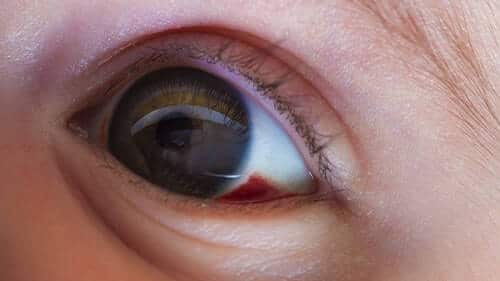Medical Malpractice: Subconjunctival Hemorrhage Injuries

Did your delivery involve a subconjunctival hemorrhage? Did your newborn experience oxygen deprivation that led to childbirth injuries because the doctor failed to act quickly?
At Rosenfeld Injury Lawyers, LLC, our personal injury attorneys handle fetal death and severe injury cases and can help your family too. Call a birth injury attorney at (888) 424-5757 (toll-free phone call) or use the contact form today to schedule a free consultation.
Subconjunctival hemorrhaging is a medical condition that occurs when a blood vessel in the white of the eye ruptures. The condition is a common occurrence in newborns that have been through difficult birth and procedures such as forceps and vacuum-assisted delivery.
Infant subconjunctival hemorrhage is commonly referred to as “red-eye.” The condition is one of the most common birth injuries in newborn babies and usually carries a favorable prognosis with proper care, monitoring, and medical treatment.
On occasion, failure to diagnose subconjunctival hemorrhaging can result in permanent impairment to the child’s vision if the white of the eye becomes infected or the cause of the red-eye is an undiagnosed infection.
Subconjunctival Hemorrhage: Diagnosis and Treatment
Typically, the healthcare provider will diagnose subconjunctival hemorrhage in newborns using visual inspection of the child’s sclera. The doctor is looking for noticeable reddish blood clotting appearing near the conjunctive next to the sclera’s clear membrane (bulbar conjunctiva) lining the whites of the eyes.
The appearance of infant subconjunctival hemorrhage caused by using forceps during delivery is often readily apparent when the infant cries. At this stage, there is typically no movement on the injury side of the face when the eye cannot be closed.
In cases where the injury caused only bruising, the paralysis on the baby’s face will usually improve in a few weeks. However, if the nerve was ruptured or torn, surgery may be required.
Within a few weeks or two, the baby’s injured sclera will absorb red blood cells causing the bright red spot to disappear. In some cases, the infant’s eye will turn yellow while the fragile blood vessels heal as a part of the normal healing process.
Sometimes, the doctor will prescribe artificial tears for severe subconjunctival hemorrhage cases that help reduce the pain and itchiness the newborn baby is experiencing.
Parents are encouraged to watch the healing process and observe the red patch. Over time, the eye may occasionally begin itching, which can be treated using over-the-counter eye drops.
In most cases, doctors will not perform testing to diagnose infant subconjunctival hemorrhages except in the delivery room to monitor the baby’s blood pressure to prevent unexpected complications, permanent eye damage, or childbirth injury.
Subconjunctival Hemorrhage: Common Causes of Red Eye
Some newborn infants suffer a birth injury or birth trauma that is a normal part of labor and delivery during the birth process, like subconjunctival hemorrhages. For example, a difficult birth could occur when the infant’s head is too large or the position of the fetus during labor and delivery is at an abnormal angle creating too much pressure on the baby’s head.
Sometimes, subconjunctival hemorrhages in newborns occur when the obstetrician exerts force during the delivery process when the baby’s head is stuck, or the child is in distress. At these times, excessive pressure is applied to a newborn’s head and face during a traumatic delivery.
When the pressure is amplified during prolonged labor, the doctor may recommend using forceps or a vacuum to assist the delivery. However, excessive force can cause serious injury to the head, face, and skull— most of which involve ruptured small blood vessels and swelling.
Infant subconjunctival hemorrhage may have been caused during a traumatic birth by any of the following.
- Forceps delivery
- Vacuum extraction
- Shaken baby syndrome
- Infections
- Rough or aggressive treatment of the mother or too much pressure on the child during or after delivery, or traumatic emergency C-section
The breakage of small blood vessels in the baby’s eyes could lead to a subconjunctival hemorrhage that appears as a bright red band on the white part of the eyes. While the condition is not always critical, where the excessive blood is absorbed in a few days, sometimes, the child can suffer severe injury and trauma to the eyes and head.
Was your child’s red-eye the result of the improper or negligent use of delivery instruments? If so, the attending medical staff may be liable for medical negligence, leading to complications like severe birth injuries, including infant subconjunctival hemorrhage.
Sudden increases in pressure by the baby coughing or sneezing could lead to a subconjunctival hemorrhage that affects one or both of the baby’s eyes.
The majority of red-eye cases that cause long-term harm are undiagnosed. This failure to diagnose and treat red eye can be classified as medical malpractice and a failure to meet the standard of care.
Complications Associated With Infant Subconjunctival Hemorrhages
Untreated subconjunctival hemorrhaging can have lasting effects on the baby’s body. In addition, if an infection causes red-eye, the infection can spread, often leading to more severe conditions.
Infant subconjunctival hemorrhage caused by birth trauma may become infected and pose the same risks if untreated, and all cases of red eye that go unnoticed can cause permanent harm to the child’s vision. These birth injuries are preventable, and medical professionals who fail to provide adequate care should be accountable for their actions.
Medical professionals can sometimes prevent this condition with a cesarean section if the difficulty arises because the baby cannot make it through the birth canal during a difficult labor and delivery.
In severe infant subconjunctival hemorrhage cases or if left untreated, this type of injury can also cause:
- Facial paralysis
- Brain Injury
- Cerebral Palsy
- Severe eye rupture
- Cranial hematomas
- Brachial plexus injury
Sometimes, infant subconjunctival hemorrhages in newborns occur when the obstetrician exerts force during the delivery process when the baby’s head is stuck or the child is in distress.
In very rare cases, newborn subconjunctival hemorrhages could lead to permanent eye damage. The doctor or ophthalmologist will determine the necessary treatment based on the severity of the condition.
Infant Subconjunctival Hemorrhage Lawsuits & Birth Injury Claims
Did your child suffer a subconjunctival hemorrhage, and you suspect your doctor or health care provider caused the preventable injury? Filing a civil lawsuit will hold the doctor, nurse, medical center, or hospital legally liable for your child’s hemorrhage.
However, to prove the case, you will need to show how their standard of care deviated from acceptable practices that lead to your child’s injury.
You or your attorney will gather evidence, review medical records, and use the assistance of medical expert witnesses to prove the facts of the case. Finally, you’ll need to develop a strong argument proving medical malpractice to ensure you receive financial compensation that covers your:
- Medical expenses
- Out of pocket costs
- Pain and suffering
If the newborn suffered other severe birth injuries, you and your family might qualify for additional damages, including rehabilitation and therapy costs and future medical expenses.
According to state law, you will have a limited time to file a case based on the statute of limitations. For example, in Illinois, you typically have two years from the time of the injury to file a claim or civil lawsuit in the appropriate court.
Claimants who wait to file a claim past the statute of limitations forfeit their rights ever to seek compensation for those injuries against the party at fault at any time in the future.
Subconjunctival Hemorrhage FAQs
Our law firm understands that many families have unanswered questions about filing a claim or speaking directly with an insurance company. A birth injury attorney answered some of those questions below.
Call our law office at (888) 424-5757 (toll-free phone call) or use the contact form for additional information.
Medical Malpractice Lawyers Handling Cases Involving Birth Injuries
Did your newborn baby suffer an infant subconjunctival hemorrhage or another birth injury, like cerebral palsy, during delivery or cesarean section? Do you believe that medical negligence contributed to their birth injuries? If so, contact Rosenfeld Injury Lawyers, LLC at (888) 424-5757 (toll-free phone number) or use the contact form to schedule a free consultation.
We also handle medical malpractice cases for families affected by birth defects or other serious birth injuries that led to severe complications or stillbirth.
Our law offices are located throughout Illinois, and if you are not close to one of our locations, we can travel to meet you. During your consultation, a birth injury attorney will review the details of your case, address your concerns and guide you through the process of litigation so that you know your rights and what to expect moving forward.
As a plaintiff, you can recover damages such and pain and suffering and medical bills. The defendant may also have to pay medical costs for the child’s entire lifetime.
If for any reason, we are unable to win or settle your case, our services will be free of charge. All confidential or sensitive information you share with our law office remains private through an attorney-client relationship.
Many medical malpractice cases have already been resolved through million-dollar settlements to ensure families have sufficient financial compensation for providing all the treatment and caring their child requires.







